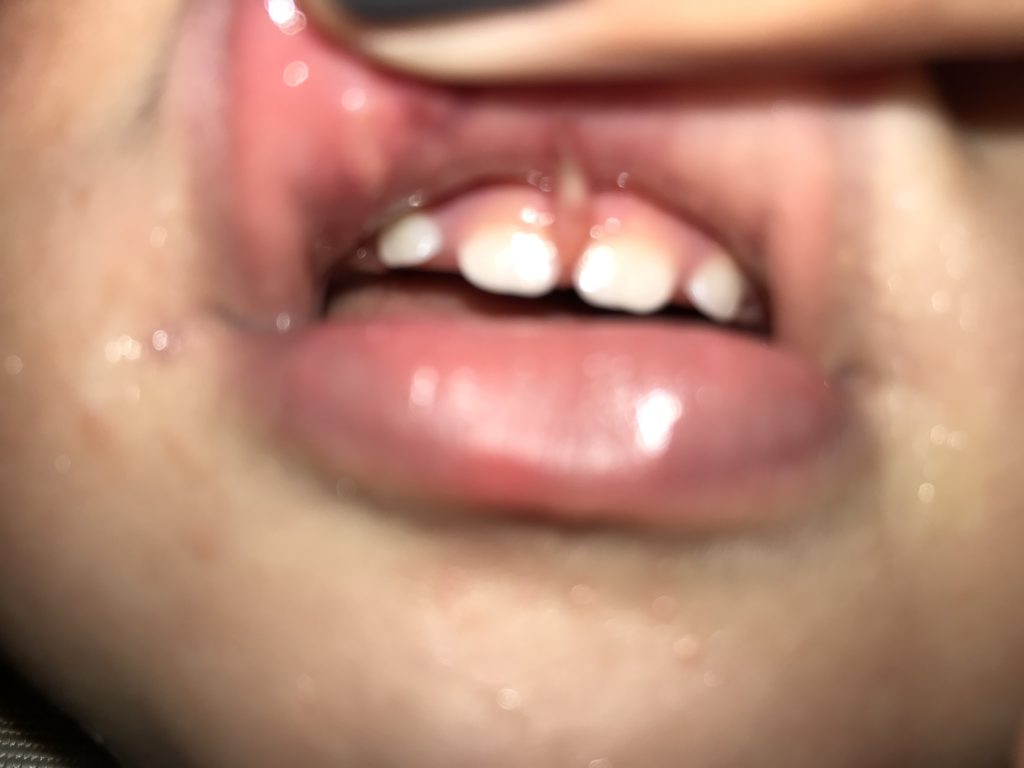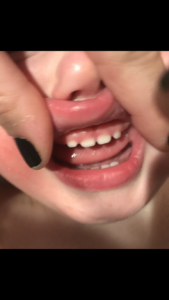The Tongue- & Lip-tie Guide II
Part 2: The Surgical Experience
Back in January, I began a countdown to my highly anticipated day of shadowing Oral & Maxillofacial Surgeon, Dr. Scott Siegel of NYC. I was going to witness firsthand the step-by-step process of TOT revisions! My goal was to gain more incite on the adverse effects of TOTs as several parents had reached out with concern. However, a week before the big day, my son fell and earned a bloody gash on the inside of his lip. As I lifted his upper lip to examine the wound, I found a tight, Class III lip-tie staring back at me. Coincidence! This ultimately shifted my lens; I was now educating myself for both professional and personal purposes. Should I have my son’s lip-tie revised? What’s the risk of not having it revised? Mine has bothered me for years – should I go through with it also? I decided to join Facebook’s NY & NJ Tongue Tie Group, where parents regularly share a wide range of concerns surrounding tongue- and lip-ties. I soon realized that this topic is more widespread than I had initially anticipated, therefore a brief newsletter on the topic wouldn’t do. And after reading other’s experiences, researching, and observing multiple live surgeries, my husband and I decided to move forward on my son’s lip-tie revision, as well as mine!
Before continuing, I encourage you to read February’s The Tongue- & Lip-tie Guide Part 1: The Potential Adverse Effects on Your Child’s Speech Development (and other areas). This newsletter, Part 2, will refer to many terms, classifications, and experiences from Part 1.
TABLE OF CONTENTS
- Terms Defined
- Professionals who perform Frenectomies/TOT Revisions
- Assessment & Evaluation Procedures
- Surgical Procedures (comparison)
- The Surgical Experience with Dr. Scott Siegel
- Shared Surgical Experiences
- Post-Surgery
- Summary & Recommendations
TERMS DEFINED
Tethered Oral Tissues (TOTs) is the collective term for tongue-ties, lip-ties, and buccal-ties (cheek) (Refer to Image A).
Tie/TOT Revision, Tie/TOT Surgery, & Frenectomy = terms referring to tongue-/lip-/buccal-tie surgery.
PROFESSIONALS INVOLVED IN THE ASSESSMENT, MANAGEMENT & REVISION OF TOTs
The TOTs surgery (or revision, or frenectomy) is performed by either an Oral & Maxillofacial Surgeon, ENT (Otolaryngologist), Dentist, or Periodontist. However, there can be several professionals involved in the management of TOTs, whether or not a revision is made. Depending on the adverse effects related to your child’s TOTs, it’s wise to have more than one set of eyes to make a collaborative decision that best meet your needs. These professionals include but are not limited to: Oral & Maxillofacial Surgeon, ENT (Otolaryngologist), Dentist, Orthodontist, Pediatrician, Speech-Language Pathologist, Lactation Consultant, Myofunctional Therapist, Nutritionist, Behaviorist.

Labial (lip) & Lingual (tongue) Frenum
ASSESSMENT & EVALUATION PROCEDURES
Assessment and evaluation procedures vary depending on the profession. A dentist and orthodontist evaluate the development of the mouth and teeth in relation to TOTs. The Speech-Language Pathologist evaluates the child’s development of the mouth and speech production related to TOTs. The Lactation Consultant evaluates the efficacy of the child’s feedings related to TOTs. Yet there seem to be two overall consistencies in evaluations across all professions. They aim to answer, “How are TOTs adversely effecting your child?” and with tongue-ties specifically, evaluating the mobility of the tongue.
Professionals may also differ in their management recommendations. For example, your child’s tongue- & lip-tie may not be affecting their speech development, so a Speech-Language Pathologist may not recommend taking any action. However, an evaluation by a Pediatric Dentist may reveal improper growth of the palate (related to tongue-ties) and a significant gap in between the two front teeth (related to lip-ties). The dentist would likely recommend a revision. While each professional’s assessment and evaluation may result in different recommendations, it important to answer the questions “How are TOTs adversely effecting my child?” and “Will a TOTs revision help him/her?”
COMPARISON OF SURGICAL PROCEDURES
| Laser | Electrocautery | Scalpel | |
| Operation Time(prep to completion) | Under 10 minutes | Under 10 minutes | 10-30 minutes (depends on whether anesthesia is given) |
| Bleeding | Virtually bloodless | Virtually bloodless | Significant bleeding |
| Suturing | No | No | Yes |
| Pain(post-surgery) | Mild-moderate | None-mild | Moderate-Severe |
| Pain Duration(post-surgery) | Varies depending on age. Children: 0-2 days of discomfortAdults: 1-2 weeks | Varies depending on age.Children: 0-2 days of discomfortAdults: 1-2 weeks | Varies depending on age. Children: 0-7 daysAdults: 1-3 weeks |
| Scarring | Virtually none | Minimal | In more than half of cases |

Scalpel

CO2 Laser
THE SURGICAL EXPERIENCE WITH DR. SCOTT SIEGEL
It was Martin Luther King Jr. Day, and most, if not all, of the tri-state area schools were closed. This meant a very busy day ahead for Dr. Scott Siegel and his team as families voyaged to NYC for their child’s (or their) TOTs revision. Families traveled from New Jersey, Connecticut, Long Island, just to receive his expertise on the topic. The office was bustling; Dr. Siegel and his staff were lucky to find a moment for a quick sip of water or to use the restroom. Yet, they entered each appointment with ease, attentiveness, and patience. It was remarkable.
Within three hours, I witnessed 7 revisions (1 infant, 5 children, 1 adult), and 2 post-surgery follow-ups. Dr. Siegel and his team welcomed each consultation by making a personal connection to their referral source (e.g. Lactation Consultant, Speech Pathologist, Pediatrician). He answered parent questions thoroughly by sharing professional experiences and evidence from current research. The most admiral expertise he offered was assurance in that parents shouldn’t feel pressured to have the revision performed at that moment if they needed time to mull over the information. However, each family easily trusted Dr. Siegel’s warm bedside manner, experience and expertise, which lead to a revision.
Infants: The 8-week-old infant was referred by a lactation consultant due to insufficient latch. He presented with a tongue- and lip-tie. The revision on the 8-week old and my son (14 months old) involved numbing gel on each tie area followed by the CO2 laser (Refer to Image C). From start to finish the revisions were under a minute. The most difficult part with this population is watching the child cry while being held down.
School-age Children: These children were referred by Orthodontists, Orofacial Myologists, and Speech-Language Pathologists. Four of the five were experiencing speech/articulation delays. The remaining child experienced discomfort eating and brushing her teeth. Each of the 5 cases presented with a combination of tongue-, lip-, and/or buccal-ties. With this age group, Dr. Siegel placed numbing gel on each of the ties, followed by a shot of Lidocaine. After waiting approximately 60 seconds, he revised each tie with the CO2 laser. From start to finish, the revision process was approximately 2 minutes long. There were little, if no tears, from these children. Adults: The adult male patient, age 60+, was referred by an Orofacial Myologist/Speech-Language Pathologist. Chief complaints included sleep apnea, mouth breathing, tongue trust, gag reflex, and overall difficulty eating and swallowing throughout his life. Dr. Siegel diagnosed a posterior tongue tie. The revision on this patient involved numbing gel, a shot of Lidocaine, and the CO2 laser. From start to finish, the revision process in total was approximately 4-5 minutes. My Class II lip-tie revision was similar, however a slightly shorter process time.
Adults: The adult male patient, age 60+, was referred by an Orofacial Myologist/Speech-Language Pathologist. Chief complaints included sleep apnea, mouth breathing, tongue trust, gag reflex, and overall difficulty eating and swallowing throughout his life. Dr. Siegel diagnosed a posterior tongue tie. The revision on this patient involved numbing gel, a shot of Lidocaine, and the CO2 laser. From start to finish, the revision process in total was approximately 4-5 minutes. My Class II lip-tie revision was similar, however a slightly shorter process time.
SHARED SURGICAL EXPERIENCES
The surgical experience varies from professional to professional. While there are some consistencies, every Oral & Maxillofacial Surgeon, Dentist, or ENT differs in their surgical technique and protocol. Below are several experiences others have generously shared to represent the range of surgical procedures.
- My son was 11 weeks old. While he was feeding well, I was concerned about his speech-development in the future. A Pediatric ENT performed the revision using the scalpel technique (Refer to Image B). There was no numbing gel or shot of Lidocaine. It was quick, and while he cried and bled for a few minutes, he immediately drank from his bottle in the waiting room. The doctor directed us to perform specific stretches or exercises several times a day for two weeks to prevent reattachment. There weren’t any problems or difficulties.
- I was 11 years old when my dentist told me I had a lip-tie. I didn’t know I had one, nor did I know anything about it. He casually explained it was causing a significant gap in between my front teeth, and it may become more uncomfortable over time, if it wasn’t already. He didn’t call it surgery, just referred to it as “a clip”. I said to go ahead and clip it. So, he put a shot of Lidocaine in it, which was definitely the most painful part, because you don’t feel anything afterwards! He clipped it using a scalpel. There was a little bit of blood but not a lot. I don’t remember having to perform any stretches – could have been told to, but I’m not sure. I had braces put on a few months later, my two front teeth are together, and I have no problems! (30-year-old male)
- I had this done as part of a bigger effort to have veneers put on. My periodontist recommended tie removal as he said my lip tie would continue to separate my two front teeth. They have always been separated, but post veneers – they didn’t want it to get worse. He used a scalpel to cut the tie. Recovery time was minimal, maybe 24 hours. On a scale of 1-10 (10 being unbearable), pain was probably a 2-3. Hardly any pain because of the numbing. I wasn’t given any post-surgery exercises. I feel the surgery benefited me as my gap hasn’t expanded and my mouth feels a little more “freeing”. (30-year-old female).
POST-SURGERY
Following a frenectomy, some professionals suggest stretches or exercises to prevent reattachment. Other doctors do not recommend any post-surgery exercises. Dr. Siegel provides each patient with a take-home packet including specific exercises per tie attachment (tongue vs. lip vs. buccal). These stretches are performed several times a day for a two-week period. His well-educated team performed these exercises on each patient following the procedure.
I mentioned there were two families who arrived for post-surgery follow ups with Dr. Siegel. Both families with infants shared positive post-surgery outcomes. They reported improved latch, shorter (breast) feedings, and improved mood (infant) post-feedings.
Let’s not forget about post-surgery pain, if any! In my personal experience, my son’s, and others who shared their experiences with me, post-frenectomy pain and/or discomfort subsided quickly, only lasting approximately 1-2 days. Neither my son or I took any form of medication following the procedure. On Facebook’s NY & NJ Tongue-Tie Group, some parents shared they felt their child’s pain required over counter medication (Tylenol, Motrin). Most are able to eat, drink, brush their teeth, and resume normal activity immediately afterward.

Pre-frenectomy (myself)

Post-Frenectomy (myself)

Pre-Frenectomy (my 14m old son)

Post-Frenectomy (my 14m old son)
SUMMARY & RECOMMENDATIONS
From professionally observing multiple frenectomies, personally experiencing one, and being the parent of a child undergoing one, I would describe this procedure as pleasant, quick, and low-risk, with the pros significantly outweighing the cons. While my lip-tie minimally impacted my life, my mouth feels less tight and freed (Images D & E). Each parent I observed post-frenectomy, and most parents in TOTs groups, regard their frenectomy outcomes positively. Of the parents and adults I interviewed, each described the tie revision as beneficial by reducing or removing their chief complaints. Positivity!
Yet while frenectomies are minimally invasive surgical procedures, it is always important to seek medical advice from trusted professionals and educate yourself.
From your fellow first time Mom and Pediatric SLP, I hope this helps. Always feel free to reach out.
Visit HIGHLIGHTS on Instagram @rachelkirsonslp to watch the surgical experience LIVE!
Rachel Kirson M. S. CCC-SLP, TSSLD


